Greyhound FAQs and Myths
If you have questions about whether a greyhound is the right breed of dog for you, we hope that you can find the answers to some of your questions here. In addition, make sure you read all of the other pages of our web site!
WHAT KIND OF PETS DO GREYHOUNDS MAKE?
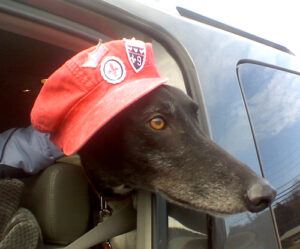
Greyhounds are gentle, affectionate, and fairly laid back dogs that make excellent house pets! They are well bred; you can trace their ancestors back for many generations!. This good breeding has eliminated a lot of behavior problems. Because they have been raised with their littermates and are allowed to do “dog” things and enjoy their growing up time together, they are highly socialized (in terms of pack order) and friendly (because they have been handled a lot by humans who care for them and train them). Their friendly nature is enjoyed by many people who meet them. They love attention and attach to their owners in a special way. Most people who adopt greyhounds are surprised at their loving and “sweet” nature and by the fact that they are fairly low energy. Many people who adopt a greyhound for the first time are totally won over to the breed and always adopt more!
HOW ARE THEY WITH CHILDREN?
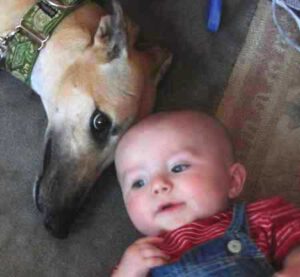
Although some greyhounds have not spent much time with children at the track, many get along very well with children because of their tolerant and friendly nature. Because they are adopted as adults, most will walk away from a child rather than to growl or snap if they are bothered. However, greyhounds, like other breeds of dogs, have their limits and should not be pushed or treated badly. Many are not used to being awakened by touch and their thin skin cannot tolerate children grabbing and/or pinching them. Children must be taught how to act around a greyhound. We profile all of our greyhounds carefully to determine which ones will get along with children. Our organization will place greyhounds into homes with children but we screen very carefully; we must know that the children have been taught and understand how to treat a dog. We require that adopters with children sign an adoption contract addendum agreeing to adhere to specific practices. Read more….
HOW OLD ARE THEY WHEN THEY COME FROM THE TRACK AND HOW LONG DO THEY LIVE?

The majority of greyhounds usually retire and become available for adoption between the ages of two and five. Some younger greyhounds may become available if they do not do well racing or do not seem to be interested in racing. Some greyhounds that have done well racing or have been used for breeding purposes can become available between the ages of six and nine. With proper care and good nutrition, greyhounds usually can live to between twelve and fourteen years of age (and some can live to be much older!) We advise people not to think about age when adopting. There are no guarantees on how long any greyhound (or any dog for that matter) will live. Our organization has seen very young dogs die while other seniors that are adopted live for many more years. Fate determines the length of any dog’s life and there is little we can do about that. Think of each experience with a dog as something special -it’s what they do!
ARE GREYHOUNDS HOUSEBROKEN?

Greyhounds live in crates at the track and are turned out four or five times a day to relieve themselves and for exercise. They seldom soil their crates. In a new home, they usually house train very quickly. Our organization fosters all dogs coming in to our program and we work on beginning house training. However, they will need follow up training in their new homes. They need to learn that your house is their crate and you have to help them learn. A crate, a fenced-in yard and a good routine is most helpful. But if you are going to leash walk your greyhound, you WILL have to make the effort to train your greyhound to relieve itself on the leash. Please expect to do some additional training when you bring your greyhound home.
WHY ARE SOME GREYHOUNDS I’VE SEEN WEARING MUZZLES?

At the track, greyhounds wear muzzles to help determine who wins the race (in the case of a photo-finish) and to prevent injuries from the excitement of the chase (bumping and nipping). When they are together in numbers, they should be muzzled because their competitive nature and eagerness to chase may cause them to nip which can tear their thin skin. Other dogs also play-nip, but their thicker coats prevent them from getting injured. We supply all adopters with a muzzle and we highly encourage them to use it. Any time that several greyhounds are together in a fenced in area, all greyhounds should be muzzled. At all of our events, we require that adopters bring a muzzle for their greyhounds and use them.
WHY ARE THE GREYHOUNDS I’VE SEEN SO SKINNY?
This is one of our most frequently asked questions!
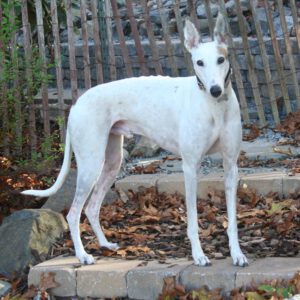
Many people who have not seen greyhounds before are shocked at their conformation. Greyhounds are actually not skinny! Their physical characteristics are unique to them just like other breeds of dog (such as a dachshund or chihuahua) They have the ability to run very fast (they are the second fastest land animal on earth) and their bodies are sleek and streamlined to do the job. They are athletes at the track and are actually fed quite well (but they burn it off). When they retire, they only require three to four cups of kibble a day. Greyhounds do not do well with extra weight on their frames. Extra weight can cause many health problems and even shorten a dog’s life. Many people make the mistake of over feeding their dogs because they want to “fatten them up.” We advise adopters against this. Usually a greyhound should not put on much more weight than a few pounds above their racing weight.
WHY CAN’T GREYHOUNDS BE ALLOWED TO RUN OFF LEASH?
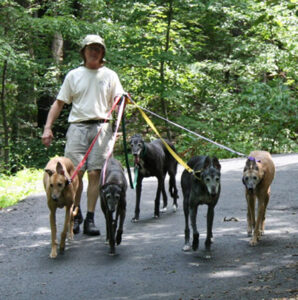
Greyhounds are sighthounds. They hunt totally by sight. They also are not good at finding their way back home because by the time they stop, they will have run a long distance. A greyhound has been taught to chase down its prey and has been bred for thousands of years to do this. A greyhound can also see a small moving creature from a very long distance away and can reach a speed of 40 miles per hour in a few strides. Allowing a greyhound off leash in an unfenced area is almost a guarantee that you will never see it again. Once they start to run, they do not know the danger associated with cars or other moving objects. Our organization has a program for helping adopters find lost dogs. However, prevention is much better. We make sure that all potential adopters understand the difference between retired racing greyhounds and other breeds of dogs. We will not adopt to anyone who thinks that a greyhound can be trusted off leash. No matter what age and how many times you have seen a greyhound go from one place to another without a leash, it only takes one time for tragedy to strike.
HOW ARE GREYHOUNDS WITH SMALL ANIMALS AND CATS?

Actually, 80% of racing greyhounds are fine with cats and other small animals (not much different than other breeds of dogs). Most adoption groups (as does ours) test retired racing greyhounds to determine which ones can live with small creatures. Those that are not small animal friendly can live fine in homes without them. Because of their training at the track, no greyhound should be trusted outside with cats and small animals. In many cases, the greyhound does not have a problem with the cats, but the cats in the house have a problem with the new greyhound. Cat friendly greyhounds can get along with one cat but have a problem with another. Much depends on personalities. Our organization encourages people without cats to adopt a dog that is not cat friendly. Adopters who have cats are required to sign an adoption contract addendum that makes the adopter responsible for the safety of all animals in the house and to make sure all introductions are done correctly. Read more……
DO GREYHOUNDS REQUIRE SPECIAL DOG FOODS?

No, like most other dogs, greyhounds need a healthy diet of a high quality dog food (which is cheaper in the long run because it provides better nutrition). Their dog food should have no corn, wheat, or wheat flour in it. Also, dog foods containing meat by-products should be avoided, as these are the ground-up remains of animals (like beaks and feet). Like other dogs, they should not have table scraps (mostly use common sense). Before buying food, some research should be done to find the food that will work best for each greyhound. Some greyhounds are more sensitive to some types of meat while others can eat just about anything. In addition, limit treats to those that are produced in the United States. Many types of treats and bones are making their way in to the United States via other countries. There are no regulations in many of these countries and sometimes harsh chemicals are used to process the food. Check labels carefully to make sure that the TREAT is from U.S. meat (and not just the packaging.
DO GREYHOUNDS SHED MUCH; DO THEY NEED REGULAR GROOMING?
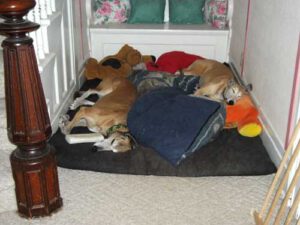
Like all dogs, greyhounds shed, but they don’t shed as much as many other breeds of dogs (and some shed more than others!). They also go through seasonal sheds like all dogs, but they do not have that heavy undercoat that needs to be maintained. They also are low-dander dogs and that makes them a good choice for people with allergies. They lack the oils that cause a “doggie” smell that other dogs have and can go longer periods of time without needing to be bathed. Greyhounds need to have their toe nails clipped on a regular basis. If toe nails are allowed to grow too long, they can have problems walking and it can even throw off their entire body and cause health problems. A greyhound’s toe nails should not rest on the ground or splay outward from the toes.
WHAT CAN I EXPECT WHEN I ADOPT A GREYHOUND?

Expect a gentle and loving dog that will warm your heart! They will need some time and patience to adapt to your home. But for a dog that has lived a different kind of life, greyhounds can adjust quickly. They are eager to please and intelligent, so it shouldn’t be hard to get your greyhound to become a part of your family. If you do the work “up front” and have patience, you will have a dog that you will like so much, that you’ll be back for more!
We get a lot of the same questions from people who visit our greyhounds at our meet and greet events. Our philosophy is to educate people about what we know about greyhounds and to be perfectly honest in the process. A greyhound might not be for everyone. You should always do the research to find out what breed of dog is best for you and your family. As much as you might want to adopt a greyhound, it may not be the right breed of dog for you. Many times people describe what they would like in a dog and, after listening, we will recommend a different breed of dog. Please scroll down for some of the “myths” surrounding the greyhound breed. We hope that this will help you as you make the decision to adopt.
MYTHS
GREYHOUNDS ARE HIGH STRUNG

This is one of the biggest myths about greyhounds! Greyhounds are like many other breeds of dogs; some are more energetic than others. But, for the most part, they are laid back and calm. The term “40 mile-an-hour couch potato” is used often to describe them! Many people also compare them to cats because they are so calm. They have an exceptionally gentle nature and do not need the amount of exercise that a lot of other large-breed dogs require. In fact, because of their laid back nature, they make wonderful pets for people living in apartments and even for senior citizens! They seldom bark except during play or with other greyhounds. Many potential adopters ask for a greyhound because they think they would make good jogging companions. But we remind people that they are sprinters at the race track. If you are looking for a lower energy good natured dog, then a greyhound is for you!
GREYHOUNDS NEED LOTS OF SPACE TO RUN

Many people tell us that they would love to adopt a greyhound but cannot because they only have a small yard or no yard at all. We think that is because most people’s image of a greyhound involves thinking of it running so fast around a race track. Greyhounds CAN run, but they do not necessarily need to run. They can and do run if they have the opportunity (in a fenced-in area), but most people are surprised to see them run only a very short time before they are ready to quit. They have short bursts of energy followed by a nice long nap! They are essentially sprinters and run for short distances at top speeds. They are not long-distance runners. Like all dogs, they need average exercise and a leash walk is sufficient.
GREYHOUNDS HAVE HEALTH PROBLEMS
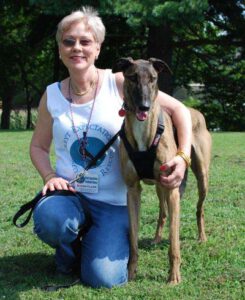
Actually greyhounds can live from 12 to 15+ years of age with average care. With the exception of old healed track-related injuries (like broken legs which usually do not impact the dog’s status as a pet) most greyhounds are healthy and resilient. They do not suffer from genetic problems (like hip displasia) that are typical in other large breeds of dogs. The health problems they experience as they get older are no different than what would be experienced in any other breed of dog. Greyhounds are different than other breeds of dogs in that they need to be treated by veterinarians who know their physical differences and requirements. Our organization provides lots of information about these differences and can make recommendations regarding veterinarians who have greyhounds as clients. Most veterinarians in our region are familiar with greyhounds today and this should not be an issue when considering adopting a greyhound.
GREYHOUNDS ARE TOO BIG

Because of their gentle nature, greyhounds are generally safe around furniture, kids, and your valuables. In fact, they are much quieter and gentler than most small breeds of dogs. They range in size from 47 to close to 100 pounds but they can navigate the smallest areas with ease. Because they have lived some of their lives in crates at the track, they are aware of their surroundings and are not the type of dog to knock things over or to be rough with children and other animals. They will “give over” rather than to challenge anything in their way.
GREYHOUNDS ARE SHY AND ALOOF
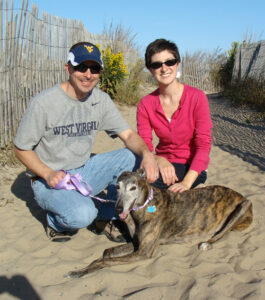
Greyhounds have been with humans and other dogs constantly from the moment they are born and are the most sociable of all dogs! They have been raised in kennels with at least 20-80 other dogs from the time they are born. They are allowed to be puppies and do puppy things like play with each other, sniff, explore, chase, chew, etc. They are also handled by their trainers from an early age and, as a result, they are used to interacting with humans. That’s why we refer to them as “fast friends.”
GREYHOUNDS AREN’T SAFE AROUND SMALL ANIMALS
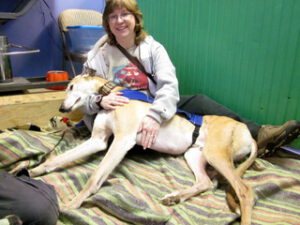
Very few, not all, greyhounds are not safe around cats and other small animals. Remember, greyhounds are no different than any other breed of dog; all dogs can chase and go after cats. However, greyhounds are taught to chase that rabbit around the track and some chase better than others based on how much of their hunting instincts have been brought out during training (as well as genetics). However, all of our available greyhounds are cat tested under all conditions before being placed into homes with other small animals. No greyhound can be considered safe with cats outdoors. All bets are off. Read more….
Greyhounds are a special breed of dog! But what makes them even more unique is that they can transition from a life of work at the race track into a home with such little effort. Ask any greyhound adopter what they think of their greyhound(s) and you will always get the same answer……..Greyt!!


